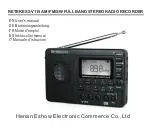
Channel Monitoring
In the Multi-Net mode, channel monitoring is performed automatically by the transceiver. In the conventional
mode, it is performed manually as described in the “Monitoring Before Transmitting” section.
Group Select
When a Multi-Net system is selected, the group select switch selects an ID code. This ID code determines the
mobile or group of mobiles that are being called and also the calls that are received. Up to 11 different groups can be
programmed in each Multi-Net system. When a conventional system is selected, the group switch selects radio chan-
nels. Therefore, changing the group number effectively selects a different radio channel. Up to 10 groups (channels) can
be programmed in each conventional system.
Supervisory Tones
In the Multi-Net mode, special tones indicate such things as when the speaking can begin and an out-of-range
condition (see “Supervisory Tones”). In the conventional mode, there are no tones to indicate these conditions. A busy
channel is detected as described in the next section, and an out-of-range condition may exist if you are not receiving any
calls or are unable to get a response from mobiles you are calling.
MULTI-NET FEATURES
Clear-To-Talk Tone
When the push-to-talk switch is pressed to transmit a message on a Multi-Net system, a short tone sounds. This
tone indicates that the radio system has been successfully accessed and speaking can begin. If no tone sounds and
“BUSY” is indicated in the display, the system is busy and the message cannot be transmitted at that time. However, if
you continue to hold down the push-to-talk switch, the system is accessed and the clear-to-talk tone sounds when the
system is available.
An exception when the busy tone sounds is when the system is busy with busy queuing programmed (see separate
description). If the system could not be accessed because of an out-of-range or other error condition, the intercept tone
sounds instead of the clear-to-talk tone. Refer to “Supervisory Tones” for more information on the busy and intercept
tones. The clear-to-talk and busy tones do not sound on conventional systems.
Two different clear-to-talk tones can be selected. One is a single beep and the other is a louder double beep. The
clear-to-talk tone can also be disabled. To select these options, proceed as follows:
1. Turn power on with the Auxiliary switch pressed. Then quickly press the Auxiliary switch to select “PTT xTN”.
2. Press the push-to-talk switch to select “PTT 1TN” for the single tone, “PTT 2TN” for the double tone, or “PTT
0TN” to disable the clear-to-talk tone. Shortly after the desired mode is selected, normal operation resumes.
Group Scan
The group scan feature is programmable on Multi-Net systems by your system operator. There is no separate
switch for selecting group scanning because it occurs whenever a system programmed for group scan is selected or
scanned (system scanning does not need to be enabled). Group scanning is indicated when not system scanning by a
dash in the group display. When system scanning is also occurring, “SCN” is indicated in the display. The system
display continues to indicate the system number with both system and group scanning.











































